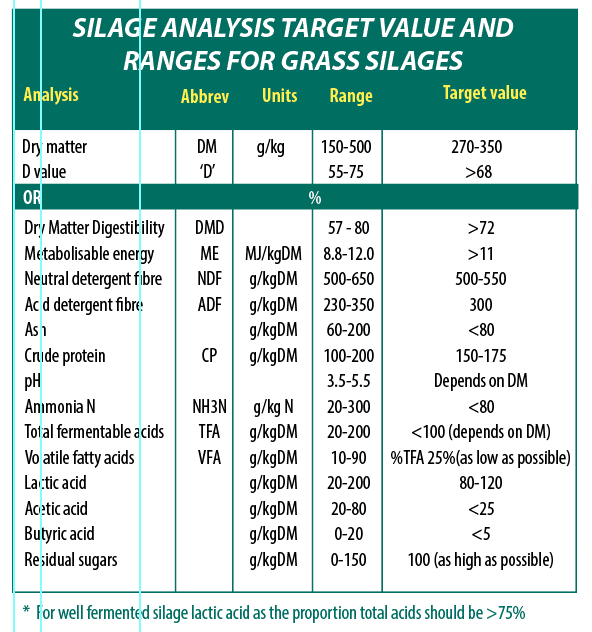 As the winter housing period approaches, now may be a good time to assess grass silage stocks and forage quality. Leafy swards comprising of at least 70% ryegrass varieties are key to a top quality silage. The Dry Matter Digestibility or 'DMD' of silage is largely influenced by the growth stage at which the grass was cut and ensiled.
As the winter housing period approaches, now may be a good time to assess grass silage stocks and forage quality. Leafy swards comprising of at least 70% ryegrass varieties are key to a top quality silage. The Dry Matter Digestibility or 'DMD' of silage is largely influenced by the growth stage at which the grass was cut and ensiled.
Like most other plants, grass goes through a vegetative stage and then a reproductive stage, at which point lignin content increases. This lignin is indigestible to ruminants and can reduce the digestibility of grass silage significantly. Where seed heads are present within a silage sample, digestibility or ‘DMD' will be below the target figure of 72%. Research has also shown that crude protein (CP, 160 vs 109g/kg DM), water soluble carbohydrates (WSC, 133 vs 107g/kg DM) and metabolisable energy (ME, 11.9 vs 10 MJ/kg DM) content decline as the grass matures.
SILAGE ANALYSIS
Why Analyse Silage?
Matching the dietary nutrient supply with that of the animal’s requirements is crucial in maintaining production and reducing losses. Failure to do this will result in over or under supply of nutrients which in turn reduces production efficiency and profitability. Analysing silage is a crucial factor in this process and as silage is the most variable component of the diet, analysis is necessary. This is as true for baled silage as it is for clamped or pit silage.
Analyse your Silage
Clamps or pits are relatively easy to analyse as you can take a cored sample in a diagonal line across the top of the silage clamp. Be sure to core as far into the silage clamp as possible to get a representative sample.
For baled silage, the best approach is to sample as many as possible. However, whilst it is not possible to sample every bale, it is advisable to take samples from bales made at different times over the season, and from areas of the farm that you know produce different quality forage. This will enable bales with different compositions to be identified and then fed to the stock where they will best meet their dietary requirements.
One problem with bales is the variation in dry matter from the top to the bottom of the bale. Ideally, take a sample from the top to the bottom ideally in three places across the bale and mix the samples well before sending for analysis.
Once all samples have been taken mix them well and pack into a plastic bag, remove all the air from the bag before sealing and send immediately to the laboratory.
Reading your silage analysis
 The silage analysis can be split into three parts. Firstly, factors associated with silage and forage in general such as Metabolisable Energy, Crude Protein, Ash, Neutral Detergent Fibre and Acid Detergent Fibre will be focussed on. These give an estimate on the quality of the forage at harvest. Secondly there are characteristics that are associated with fermentation such as, pH, Lactic acid, Total Volatile Fatty Acids and Ammonia-N. These give an indication of how well the preservation process has been controlled. Finally there are two factors that show both crop quality at harvest and fermentation, these are Dry Matter and Water Soluble Carbohydrate (WSC) or sugars.
The silage analysis can be split into three parts. Firstly, factors associated with silage and forage in general such as Metabolisable Energy, Crude Protein, Ash, Neutral Detergent Fibre and Acid Detergent Fibre will be focussed on. These give an estimate on the quality of the forage at harvest. Secondly there are characteristics that are associated with fermentation such as, pH, Lactic acid, Total Volatile Fatty Acids and Ammonia-N. These give an indication of how well the preservation process has been controlled. Finally there are two factors that show both crop quality at harvest and fermentation, these are Dry Matter and Water Soluble Carbohydrate (WSC) or sugars.
Drummonds provide a silage testing service and can advise on feeding plans based on this. For more information, talk to your local Drummonds Technical Sales Advisor to discuss how we can help you.
Article written by: Bill Reilly, Drummonds Technical Sales Advisor Mob: 086 - 061 2901

